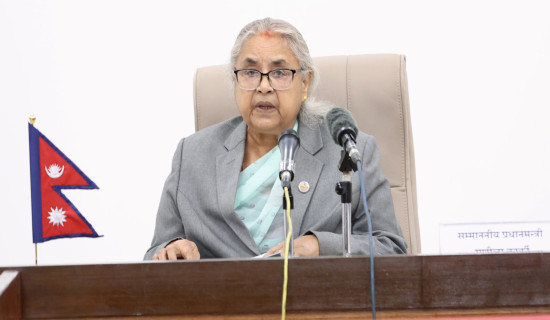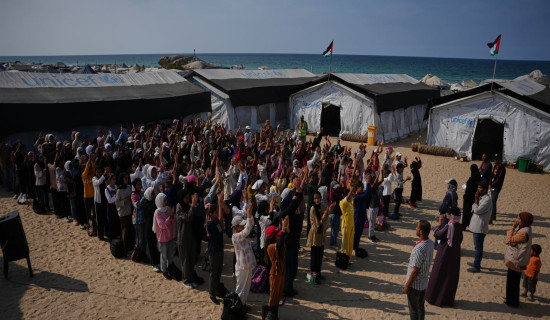- Tuesday, 18 November 2025
The World In Constant Crisis
North-South: A Programme for Survival, widely referred to as the Brandt Commission Report stated 1980 (p.30), “The crisis through which international relations and the world economy are now passing presents great dangers and they appear to be growing more serious.” True to these words, the crisis has become severe and grown hotter today. The severity of crisis is undeniable in wide ranging areas fueling a pervasive sense of despair. With the world’s amassed power and capacity to devastate the world in mere seconds, fears of drifting towards a Third World War loom large.
The end of the Cold War followed by the disintegration of the Soviet Union put the bipolar world order behind. The order put in place after the World War II began fraying yielding to a US-led unipolar moment. The 9/11/2001 terrorist attacks on America signaled the decline of unipolar moment. Gregg Caristrom argues in Foreign Affairs essay that “US influence is undeniably on the wane, but China and Russia are not yet Middle Eastern powers.” United States, he writes, “no longer has the power or standing to impose a regional order on its terms.” There is a leadership vacuum, with no checks and balances or security guarantor either at the global or regional level. A new world order is struggling to be born. Whether it would be peaceful or violent, remains uncertain.
Hot wars
The world is confronting two hot wars in Europe and the Middle East. Eurasia has emerged as a chessboard, where the struggle for global primacy is being played. Russia’s invasion of Ukraine on February 24, 2022 and Hamas’ terrorist attacks on Israel on October 7, 2023 have widespread impacts across the globe. Israelis have been fighting the longest war since 1948. Added to them are maddening arms race and the heightened risk of destructive and disruptive cyber-attacks, targeting critical infrastructures. Taken together, these factors add an extra-layer of complexity triggering a chain reaction of events, pushing the world on a slippery slope.
The outbreak of COVID-19 pandemic in 2019 was once in a century phenomenon, reminiscent of the 1918 influenza pandemic known as Spanish flue in the waning months of WW I. The global pandemic crossed borders, oceans and triggering economic contractions compounding the human and economic toll. This caused escalation in geopolitical tensions, exacerbating existing geopolitical stresses and strains and leaving behind reverberating effects. COVID-19 unlike the Spanish flue emerged in an interconnected world grappling with US-China trade tensions, and discontents related to globalisation, raising the questions about the future of global order. The cumulative effects were manifested in rising debt burden, populism, and inward looking tendency, economic nationalism, growing intolerance and right leaning political moment across the pluralistic world.
The pandemic forced nations to prioritise social spending over economic diversification or infrastructures development and outbound investment. It was also a time of global competition over technology, competition and information infrastructure threatening global connectivity. Institutions established after the World War II, the United Nations, the Bretton Woods Institutions, World Trade Organisation, and other international institutions faced challenges of purpose and power even prior to the eruption of the pandemic. Global institutions did little in fighting the COVID-19 crisis as in financial crisis in 2008-2009 decade earlier. Even the institutions that emerged after the onset of the Cold War stand inadequate.
While there is a massive social awakening, alongside widespread use of social media, its influence and credibility are questioned. There are growing signs of pessimism, frustration, ideological confusion, and radicalisation of politics. The world is witnessing worrying trends characterised by growing inequalities, communalisation of politics, politicisation of state institutions, ethnicisation of polity and politicisation of ethnicity. These trends are generating toxic signals, deepening fault lines and creating flashpoints in various regions across the globe, exacerbating geopolitical tensions worldwide.
Timothy W. Martin and Dasi Yoon write in The Wall Street Journal that North Korea’s ability “to unleash some form of nuclear attack on the world has never looked so credible.” North Korea is the only state to have carried out a nuclear test this century. In January 2024, North Korean leader Kim, a descendent of the dynastic communist family, abandoned a “foundational doctrine” of peaceful reunification built by his grandfather, and declared South Korea as the main enemy. He has backed Russia’s attack on Ukraine, and reportedly sent short-range missiles to Russia for fighting Ukraine. Russian President Vladimir Putin, considered to be “Korean people’s closest friend,” is expected to visit Pyongyang this year, elevating Pyongyang on the global agenda higher than it had been in years. Reports indicate growing nexus between Beijing, Pyongyang and Moscow over their shared antagonism toward Washington.
America takes the Ukraine war as democracy vs. autocracy. Politics is divided in the US over its aid to Ukraine. It is testing the limits of Western powers in a changing world. The thinking in the West indicates that Russian victory would embolden Russian President Vladimir Putin to threaten other neighbours. French President Emanuel Macron’s announcement that sending Western troops to Ukraine “should not be ruled out,” writes Roger Cohen in The New York Times, “has shattered a taboo, ignited debate, spread dismay among allies, and forced a reckoning on Europe’s future.” Since 2022, the West has sought to contain the conflict in Ukraine, and considers “the defeat of Russia is indispensable to the security and stability of Europe.” President Putin reacted sharply threatening the “use of nuclear weapons if Western allies come to Ukraine’s aid.”
Complex challenges
We live in an increasingly interconnected world where nations’ destinies are intricately interwoven. Nepal’s geostrategic position between the rising powers - China and India - is complex and fragile. The Sino-India border clashes in June 2020, the first in 45 years, highlight the complexity of relations of these two challenging competitive powers.
In navigating these complex challenges, Nepal must exercise heightened care and vigilance to shield itself from unpredictable impacts of geopolitical shifts and waves to best safeguard its national space and honour. It is time to audit the past honestly, analyse present developments minutely and their possible implications on Nepal’s national interests to develop narratives and look to the future with a broader perspective in mind. Any approach to address crises should be holistic. No problems are curable independent of each other.
(The author is former foreign affairs advisor to Prime Minister of Nepal.)
















